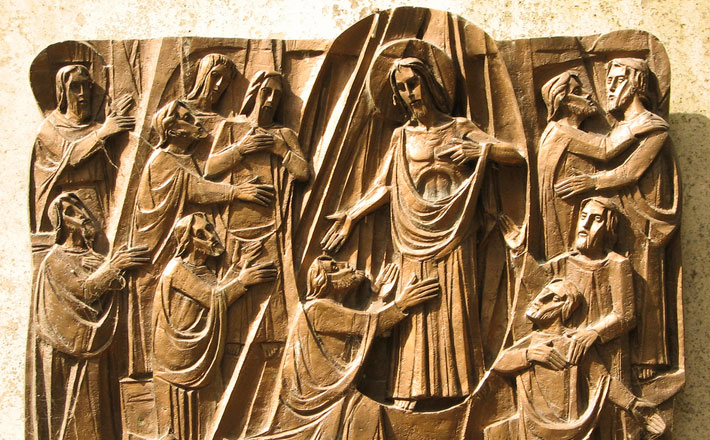Commentary on Acts 4:32-35
The portrayals of Christ-following community in Acts 2:42-47 and 4:32-37 raise red flags for many Euro-American readers.
Some liken it to a kind of “Christian communism,” believing that such extensive sharing — so that “everything they owned was held in common” (4:32) — is not only unrealistic, but dangerous.1 These texts are idealistic, but they name facets of the earliest community’s experience, character, and intentions. Whatever happened historically, Luke’s depictions proclaim a message as purposeful as it is provocative, and worth our ongoing deliberation.
I. The literary context: The birth of the church
According to Acts, the early community of Christ-followers arises in response to Pentecost (2:1-41), and thereafter devotes itself to worship, instruction, fellowship, and sharing (vv. 42-45). In Acts 4:4 Luke estimates the community at 5,000 males (cf. 2:41, 47), but Luke’s numerical counts may be hyperbolic for rhetorical impact (cf. 4:16; 17:6; 19:10). Just before the text at hand (4:32-35), Peter and John are examined and released by Jerusalem’s leaders (4:1-22), which inspires the community to pray (vv. 23-31). In doing so, the Holy Spirit fills them so that they speak God’s message “with boldness” (4:31; cf. 4:8, 13).
What follows in Acts 4:32-35 is just as important: the contrasting examples of the generosity of Barnabas (4:36-37) and the deceit of Ananias and Sapphira (5:1-11). The two stories feature opposing reactions to the call to share, and more importantly the acts of opposing forces. Whereas Barnabas’s actions correspond with those inspired by God’s Spirit (cf. 4:31-35, 36-37), those of Ananias and Sapphira are attributed to Satan (5:3). However similar the donations of these paired examples, the narrative aligns their respective generosity and refusal with cosmic forces — which explains the condemnation of the latter couple (5:1-11).
II. The text at hand: “Of one heart and soul”
No other New Testament passage depicts the ideal of sharing with the Christ-following community so vividly:
“Now the whole group of those who believed were of one heart and soul, and no one claimed private ownership of any possessions, but everything they owned was held in common … There was not a needy person among them, for as many as owned lands or houses sold them and brought the proceeds of what was sold. They laid it at the apostles’ feet, and it was distributed to each as any had need.” (Acts 4:32, 34-35).
Luke’s depiction of communal unity and sharing would certainly have appealed to prevalent virtues in antiquity — whether the principles of historic Israel (“There will be no one in need among you,” Deuteronomy 15:4-11), Greek ideals of friendship (“Among friends everything is common,” Aristotle, Eth. nic. 9.8),2 ideal philosophical communities (e.g., Iamblichus, Life of Pythagoras, 30.167),3 or the practices of hospitality (e.g., Pliny describes one’s possessions as belonging equally to one’s guest, Ep. 1.4.3). In addition, many Christian writings express strong convictions about the importance of sharing material goods, especially on the part of wealthy believers with those in need (2 Corinthians 8-9; 1 Timothy 6:7-10, 17-19; James 2:1-7; Did. 4:5-8). This conviction does not diminish quickly in the ensuing centuries.4 And so, given ancient virtues and Christian convictions, Luke’s audiences likely found the idealism of Acts 4:32-35 more appropriate than surprising. And yet, later instances in the narrative show that such singularity of heart did not mark every chapter of the church’s story (5:1-11; 6:1-7).
Furthermore, the passage notes briefly that “great grace (charis) was upon them all” (4:33b). While the phrase is ambiguous (grace with whom?), a parallel statement in 2:47 (“and having the goodwill [charis] of all the people”) implies in 4:33b the community’s favor with outsiders — very possibly due to their visible generosity.5 The same benevolence seems to enhance the apostles’ testimony, which is given “with great power” ((dunamei megale, v. 33) — language used elsewhere in Acts to describe miraculous signs that inspire faith (8:13). In short, the community’s generosity itself becomes a tangible “sign” that authenticates its message of Jesus.
III. Significance: An embodied witness
The utopian quality of Luke’s vision bars it from being a simple yardstick for measuring all forms of Christian community — a recipe for a host of failing grades. Instead, Acts 2:42-47 and 4:32-35 read best not as blueprints for today but as glimpses of dynamic experiences by a community enlivened by God’s Spirit. And so, these texts say less about model church practices and more about the dynamic power of God among believers.
And yet, the jarring features of radical generosity in Acts 4:32-35 should not be dismissed. As Luke Timothy Johnson observes, throughout history the church has far too often been a “sign of wealth rather than of poverty and has aligned itself with the rich and powerful on earth more than the weak and lowly.”6 How the radical sharing of Acts 4:32-35 speaks to our own church cultures is an open question, but certainly practices of “inspired” generosity would lend greater substance to our testimony.
In view of the focus of our Gospel reading (John 20:19-31) on “seeing” and faith, Acts 4:32-35 asks similarly: How might the community of Christ-followers itself be a “sign” that encourages belief? Despite the idealism of Luke’s vision, the narrative’s call for an embodied witness on the part of Jesus’ followers stands. As church, how do we embody the message of Jesus by our life together?
Notes:
1 The phrase “Christian communism” is named by Mark Allan Powell as the opinion of others in What are they Saying About Acts? (Mahwah, New Jersey: Paulist Press, 1991), p. 77.
2 Argued by Luke Timothy Johnson, Sharing Possessions: Mandate and Symbol of Faith (Philadelphia: Fortress Press, 1981).
3 So Abraham Malherbe, Social Aspects of Early Christianity (2nd ed.; Eugene, Oreg.: Wipf & Stock, 2003), p. 90.
4 See Irenaeus, Against Heresies 4.13.3; Basil On Avarices; John Chrysostom, Hom. Rom. 7. On this topic, see Charles E. Gutenson, The Right Church: Live Like the First Christians (Nashville: Abingdon, 2012), pp. 81-95.
5 The Greek conjunction gar (‘for,’ not in the NRSV) in v. 34 connects it directly to v. 33b.
6 Johnson, Prophetic Jesus, Prophetic Church: The Challenge of Luke-Acts to Contemporary Christians (Grand Rapids: Eerdmans, 2011), p. 125.


April 12, 2015